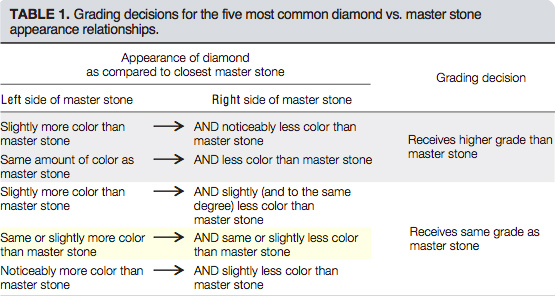Colour - Detail
for Colour...
In Detail
A qualified diamond grader is trained to asses a diamond for intensity of colour or lack there of.
A colourless diamond is prized for its lack of colour and is commonly referred to as a “white” diamond. On the GIA colour scale, diamonds range from D-Z in colour. D is considered colourless. Subtle differences between the grades are very difficult to determine with the untrained eye. A controlled lighting environment with minimal background distractions is used when grading diamonds for colour.

Remember as a diamond purchaser, you will very rarely, if ever be exposed to these conditions. So it is recommended that you view your diamonds in a natural light. Many retailers use enhanced lighting to dramatically alter the appearance of their diamonds.
The Solid Gold Diamonds showrooms have been designed to maximize natural light for this very reason. Showing a diamond in natural lighting gives you a realistic view of how your diamond will perform in your everyday environment.
Although white diamonds appear colourless, many do possess a hint of colour. D coloured diamonds are those which show no other colour when viewed through the pavilion.
As the diamond colours progress down the scale, slight yellow tints become apparent. In some markets this can be desirable though most consumers prefer the look of a crystal clear diamond.
The clearer the diamond colour, the more highly prized the diamond becomes. D coloured diamonds will fetch a premium over other bright white diamonds. It seems to be straightforward to assume that all D coloured diamonds will look the same, and all G coloured diamonds will look the same. As with all characteristics of diamond grading, we need to remember of the variances that can occur.
These variances can also determine the price of a diamond and may be the reason why two D coloured diamonds of similar characteristics vary greatly in price.
To obtain the colour grade, a qualified diamond grader will use a “master set” of diamonds. A full master set will contain all diamonds coloured D-Z. Be aware that it is not uncommon for some to use Cubic Zirconia or simulated diamonds in their master sets. Unfortunately this does not always lead to accurate colour grading.
At Solid Gold Diamonds we believe investing in quality products for our in house laboratory means our clients receive accurate grading of only the most beautiful diamonds. That is why we have complete natural diamond master sets.
All of our diamonds available for sale online are internationally certified. We source our diamonds from all over the world, ensuring they have a chain of custody. Once they arrive at our offices, our trained diamond graders and gemmologists, check every diamond against its corresponding certificate to ensure there are no discrepancies. To check the colour grade, we use our natural diamond master sets. This enables our team to confidently provide you with the best diamonds on the market.
A diamond grader is trained to assess and compare each stone against the master set. To award the colour grade, the diamond must appear “whiter” than the colour below but “darker” than the colour above. This leads to many diamonds only just making the colour grade.
For example, a diamond grader assesses a diamond against his master set and comes to the conclusion that it is a G colour. He then assesses another diamond, which is slightly “darker” but still “whiter” than the H colour in his master set. This diamond is also awarded a G colour.
A seasoned diamond merchant will charge a slightly higher price for the higher G coloured diamond, even though both diamonds will have the GIA certification stating they are G coloured diamonds. An example provided by GIA to assist with diamond grading shows how a grader might come to his conclusion.

The Hue of a diamond is a very important factor in the price and one that will very rarely be mentioned when considering a white diamond. What most retailers won’t tell you or won’t know is that colourless or white diamonds are assessed based on their hue. Within the colourless diamond grading scale there are three undertones that must be considered. These are known as the grey scale, yellow scale and the brown scale.
GIA colour diamond grades are compared to the yellow scale as this is considered the most desirable. Colourless diamonds will still be awarded a colour grade D-Z, however should you have a diamond G coloured diamond from each colour scale side by side, the difference in hue may be very noticeable.
This difference will determine the price difference as well. Diamonds that appear on the yellow scale will command a premium over those on the grey or brown scale.
When a diamond is set into a piece of jewellery, it is almost impossible to determine the colour. Our team is able to assist in identifying the colours of all our diamonds and provide full GIA reports to accompany them. When considering a diamond, we welcome you to speak with one of our trained diamond graders to discuss the best colour options for your chosen setting.
